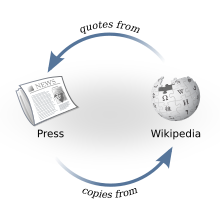循環報導

| 訊息誤導與造謠 |
|---|
 |
循環報導,又稱虛假確認,是來源批判的情況之一,指一則消息以看似出自多個獨立來源的形式出現,實際上僅出自單一來源[1][2]。部分情況中,該問題由其他媒體搜集訊息時過於草率而引起。然而在其他情形下,這個情況可能是由原創者故意捏造多個相似內容的來源,目的是增強人民對其訊息的信任[3]。
循環報導問題會在不同領域出現,包括情報搜集、新聞和學術研究。尤其在軍事情報方面,由於原始來源傳遞錯誤訊息的可能性非常高,加上報告鏈更容易被遮蓋,該問題受到特別關注。2002年尼日鈾偽造品事件是情報部門循環報導的經典實例[4]。
維基百科的例子[編輯]

維基百科偶爾會被批為循環報導的來源[5][6]。因此,維基百科建議研究人員和記者警惕或儘量避免使用維基百科作為直接來源,而把焦點放在一篇條目中有參考資料而且經驗證的內容[7]。在下列實例中,由於循環報導,不實訊息在維基百科和新聞來源中傳播。蘭德爾·門羅在他的諷刺漫畫《Xkcd》中將這一現象稱為「引文生成反應」(Citogenesis)[8]。
- 維基百科與《北方回聲報》:2014年1月,一位匿名用戶在英國喜劇演員兼廣告節目主持人戴夫·格羅曼的條目中添加了一段論述,稱「他因受贊助商邀請參加環太平洋國家的搭便車之旅而告假」。就在這個說法遭受質疑時,東北英格蘭地方日報《北方回聲報》於之後(2014年9月)發表文章,引用該條目為證明。最終,格羅曼於2016年11月22日在他的英國電視節目《戴夫·高曼:暢享現代生活》中親自確認該消息係捏造[9]。
- 維基百科與《明鏡》:2009年針對卡爾-特奧多爾·楚·古滕貝格[10][11]。
- 維基百科與《獨立報》:2007年,有假消息稱沙查·巴隆·科恩在高盛上班[12]。
- 維基百科與Coati:2008年,一名美國學生在修訂英文維基百科的Coati(英語對南美浣熊亞族——包含長鼻浣熊屬與南美浣熊屬——物種共通的俗稱)條目時增加內容「也被稱為......巴西土豚」,致使隨後許多人引用或是用這一未經證實的暱稱,使其成為廣泛共識,包括《獨立報》[13]、《每日快報》[14]、《地鐵報 (英國)》[15]、《每日電訊報》[16] 、芝加哥大學出版的一部著作[17]及劍橋大學出版的一份學術論文[18]。
參見[編輯]
參考資料[編輯]
- ^ Sterzer, Marcus; McDuff, Patrick; Flasz, Jacek. Note to File—The Challenge of Centralized Control Faced by the Intelligence Function in Afghanistan (PDF). Canadian Army Journal. Summer 2008, 11.2. (原始內容 (PDF)存檔於2012-03-05).
- ^ Rozen, Laura. The Cocktail Napkin Plan for Regime Change in Iran. Mother Jones. 2008-06-07 [2019-06-26]. (原始內容存檔於2020-11-09).
- ^ Hurley, Micheal T.; Smith, Kenton V. Chapter 8: The Aviv Report. I Solemnly Swear: Conmen, Dea, the Media and Pan Am 103. New York: iUniverse. : 129 [2019-06-26]. ISBN 0-595-29947-4. (原始內容存檔於2020-07-29).
Circular reporting occurs when what is reported is fed back to the originator in revised fashion which makes it difficult to objectively view the end product until you can trace back the sources to determine where the original information actually came from. Pan Am would eventually try to play that game by trying to introduce into court news reports that they themselves had a hand in producing.
- ^ Drogin, Bob; Hamburger, Tom. Niger Uranium Rumors Wouldn't Die. Los Angeles Times. 2006-02-17 [2019-06-26]. (原始內容存檔於2017-10-12).
This became a classic case of circular reporting," said a U.S. intelligence official who spoke on condition of anonymity because he is not authorized to talk to reporters. "It seemed like we were hearing it from lots of places. People didn't realize it was the same bad information coming in different doors. This is an interesting example of circular reporting.
- ^ Timmer, John. Wikipedia hoax points to limits of journalists’ research. Ars Technica. 2009-05-08 [2019-06-26]. (原始內容存檔於2012-04-14).
- ^ Harrison, Stephen. The Internet’s Dizzying Citogenesis Problem. Slate. 2019-03-07 [2019-07-03]. (原始內容存檔於2021-01-07).
- ^ Wikipedia:引用維基百科
- ^ Munroe, Randall (編劇、藝術家). 〈Citogenesis"〉 《xkcd》, 第978期 (2011-11-16). 原始內容 存檔於2011-11-18. [2020-05-24]. 存档副本. [2020-05-24]. 原始內容存檔於2011-11-18.
- ^ Hardwick, Viv. Mears sets his sights on UK. The Northern Echo. 2014-09-09 [2019-06-26]. (原始內容存檔於2014-09-29).
He once hitchhiked around the Pacific Rim countries
- ^ Wie ich Freiherr von Guttenberg zu Wilhelm machte. Bildblog. 2009-02-10 [2019-06-26]. (原始內容存檔於2019-04-05) (德語).
- ^ kdawson. False Fact On Wikipedia Proves Itself. Slashdot. 2009-02-11 [2019-06-26]. (原始內容存檔於2020-01-23).
- ^ Wikipedia Article creates Circular references. Tech Debug. 2009-04-19 [2019-06-26]. (原始內容存檔於2019-04-05).
- ^ Brown, Jonathan. From wallabies to chipmunks, the exotic creatures thriving in the UK. The Independent. 2010-06-21. (原始內容存檔於2014-05-21).
Coati (also known as the Brazilian aardvark): found in Cumbria
- ^ Ingham, John. Exotic animals could wipe out native wildlife. Daily Express. 2010-06-21 [2019-07-05]. (原始內容存檔於2020-07-28).
There are also about 10 Brazilian aardvark in Cumbria
- ^ Scorpions, wallabies and aadvarks 'invading Britain'. Metro. 2010-06-21 [2019-07-05]. (原始內容存檔於2010-06-25).
There are thought to be ten coatis, a kind of Brazilian aardvark, in Cumbria
- ^ Leach, Ben. Scorpions, Brazilian aardvarks and wallabies all found living wild in UK, study finds. The Daily Telegraph. 2010-06-21 [2019-07-05]. (原始內容存檔於2010-06-25).
- ^ Randall, Eric. How a Raccoon Became an Aardvark. The New Yorker. 2014-05-19 [2019-06-26]. (原始內容存檔於2014-05-23).
- ^ Safier, Neil. Beyond Brazilian Nature: The Editorial Itineraries of Marcgraf and Piso’s Historia Naturalis Brasiliae. Groesen, Michiel van (編). The Legacy of Dutch Brazil. New York: Cambridge University Press. 2014: 179 [2020-05-24]. ISBN 978-1-107-06117-0. (原始內容存檔於2022-06-21).
In the case of the Coati, for instance, also known as the Brazilian aardvark, Buffon explained that “Marcgrave, and practically all of the Naturalists after him, said that the aardvark had six toes in its hind feet: M. Brisson is the only one who has not copied this error of Marcgrave.”
